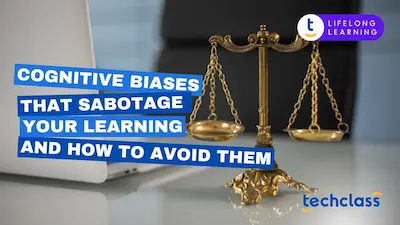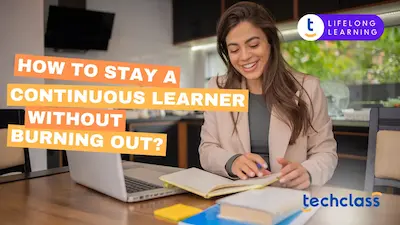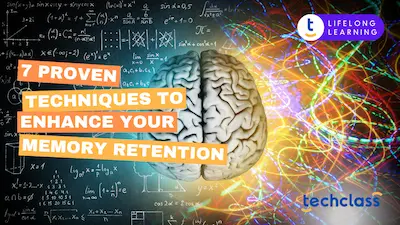
While the final result of achieving educational milestones is exciting, the journey can be pretty challenging. It is like walking through a dark tunnel, looking at a light at the far end. It becomes even tougher when you are a professional balancing a career with continuous education. This demanding situation can occur due to numerous learning obstacles. Whether you're aiming to advance in your current field, switch careers, or simply expand your knowledge, understanding and overcoming these obstacles can make all the difference.
This article will describe how to identify and remove learning obstacles so that any factor does not slow down your learning progress.
When it comes to learning, there are many obstacles. We have all experienced moments of feeling bored with our studies or needing access to the necessary facilities. These are all examples of learning barriers. Essentially, anything that prevents a student from fully engaging in the learning process is a learning obstacle or a barrier. When faced with these difficulties, a person or group faces resistance or dissatisfaction and cannot complete their learning goals.
Speaking of obstacles, both external and internal factors can lead to them. Hectic schedules, excessive work, and a shortage of supplies or technology are considered external factors. On the other hand, people's past experiences, emotions, or mentalities can be recognized as internal factors. Moreover, interactions between external and internal elements also create learning obstacles.
Emotional, motivational, and personal barriers are the three primary types or categories of learning obstacles. Let's go through each one.
We all deal with a great deal of emotions on a daily basis. Sometimes, these emotions make us judge our capabilities and feel incompetent. When it comes to learning, this can lead the learner to never finish what they started or not even try learning something new at all. Let’s take a close look at emotional barriers.
Remember when COVID-19 forced the world to change the way we lived, learned, and worked? Many people struggled to adapt to those changes, which is a great example of resistance to change. The same thing happens with learning. You may feel comfortable with the status quo and fear the unknown that comes with new knowledge.
This resistance can stem from a fear of stepping out of your comfort zone and adapting to new methods or information. Therefore, it is important to understand that even though starting or getting used to something new isn’t easy, it can open new doors to improvement. Also, it is equally important to recognize the value of stepping outside of comfort zones and maintaining an open mind when it comes to upskilling and cross-skilling.
When we do something, the unsaid expectation is that it will be successful. Even the idea of not succeeding can be paralyzing. This fear can prevent you from attempting to learn something new, as you might be overly concerned about the potential negative outcomes. This prevents you from picking up useful skills and seizing unique possibilities.
Learning and trying new things is only sometimes about the end result. It is about what you gain as a professional and person in your life. Therefore, practicing gratitude and celebrating small victories, like finishing a lesson quickly, can help overcome this fear.
Social dynamics can greatly influence learning. It’s easier to learn when you are in a nurturing workplace with people who support your growth. If peers are not supportive or skeptical of the value of learning, this can create a negative environment. The pressure to conform to group norms can discourage you from pursuing further education.
To overcome this barrier, you must first be attentive to how you feel. It is important to stay true to your values and make decisions based on what you believe is right rather than what others expect. Surrounding yourself with supportive friends who respect your choices and seeking guidance from trusted mentors can also help you resist negative influences. Setting clear boundaries can also help.
Focusing and finding a distraction-free atmosphere when learning as a professional can be difficult. Emotional distress, anxiety, or personal issues can make it difficult to concentrate on learning tasks. Attention spans have also decreased due to the widespread usage of smartphones and other digital gadgets. Without proper focus, absorbing and retaining new information becomes challenging.
To overcome a lack of focus, you can break tasks into smaller, manageable steps and use techniques like the Pomodoro Technique to maintain concentration. Additionally, minimize distractions by creating a dedicated space in your office or home and setting achievable goals for each study session.
If a learner does not have a solid foundation in the subject, it can be difficult to build new knowledge on top of it. This lack of background can lead to frustration and decreased motivation to continue learning.
To overcome this, you need to understand that learning comes in stages, and no stage should be omitted. Remember when you learned your language? First, you knew the alphabet, then you started reading small words, then you learned grammar, and finally, you started practicing language by using it. That is the same for any subject. Taking introductory courses or essential resources on the topic or seeking help from mentors or peers who can provide guidance and fill in any knowledge gaps can significantly help.
When your organization sees gaps in employee skills with new technological advancements and other areas, they conduct trainings. However, you need to know the relevance or benefits of the training in order to be motivated. Without a clear understanding of how the training will help them achieve their goals, you may not be fully engaged.
Here, your organization is responsible for connecting the training objectives to your personal or professional goals, highlighting the benefits and potential opportunities. Do your own research and find out how the trainings can benefit you.
With specific, achievable goals, it can be easier to stay motivated. Clear goals provide direction and a sense of purpose, helping learners stay focused and committed to their educational pursuits.
To overcome a lack of clear goals, begin by defining specific, measurable, achievable, relevant, and time-bound (SMART) objectives that guide your learning journey. Regularly review and adjust your goals to ensure they remain aligned with your progress and aspirations.
Everyone learns differently. Some people have trouble with numbers and find tables containing figures disturbing. While some people have no difficulty identifying differences in photos, others do not. Some people remember sounds more easily than images. Traditional educational methods might only cater to some learning styles, making it difficult for some individuals to absorb information effectively.
You can experiment with various learning methods, such as visual aids, audio materials, hands-on activities, and interactive technologies, to find what works best for you. Additionally, seek resources and instructors offering diverse teaching approaches, ensuring a more personalized and practical learning experience. For example, opting for an educational institute like TechClass that supports students by providing lessons with translation options, video materials, and textual content can help.
Disabilities, whether physical (like hearing or vision impairments) or neurological (such as dyslexia or ADHD), can pose significant challenges to learning. These barriers require specific accommodations and teaching strategies to ensure effective learning.
To overcome physical or neurological impairments, utilize assistive technologies and adaptive tools to accommodate specific needs, such as screen readers, speech-to-text software, or specialized learning apps. Also, communicate your needs to educators and seek tailored support services to ensure an inclusive and accessible learning environment.


